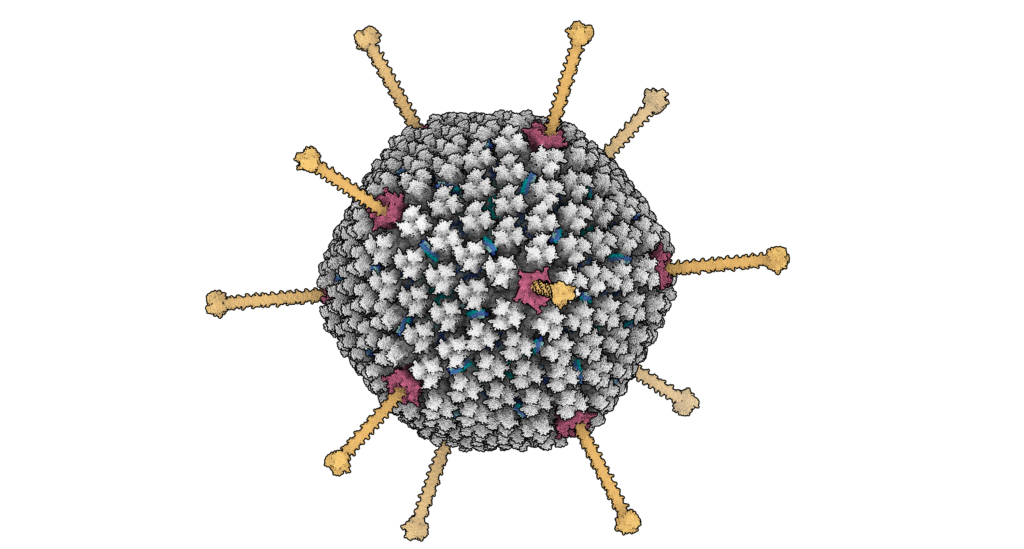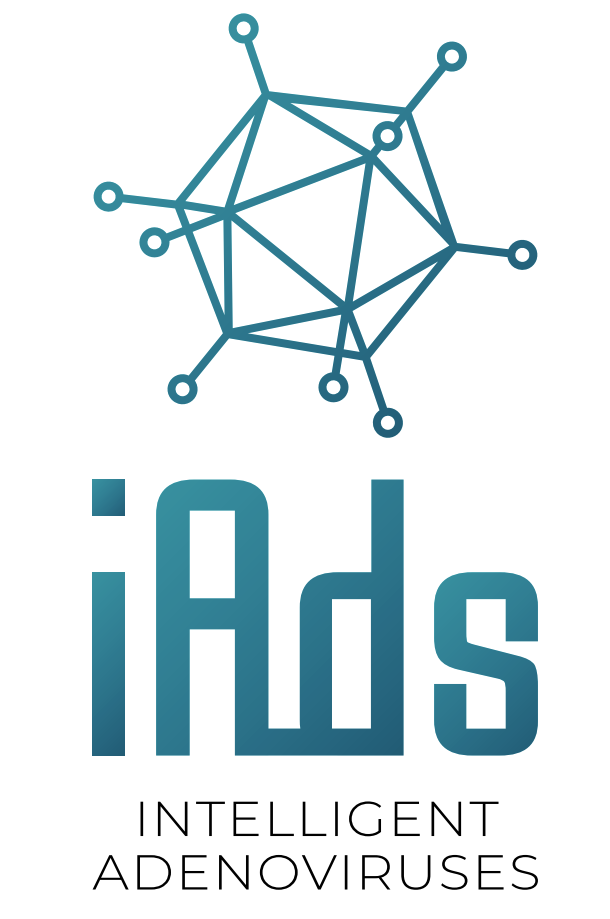This page will provide you with answers for your questions about iAds. If there should still be any questions left, do not hesitate to contact us.
- What are adenoviruses?
Adenoviruses were first isolated in 1953 when trying to grow cells from resected adenoids (tissue in the back of the throat of children), hence the name “adeno-virus”. In humans, members of the family “Adenoviridae” typically cause mild symptoms resembling the common cold, sore throat, pink eye, and/or diarrhoea.
Adenoviruses consist of a DNA genome (unlike coronaviruses which have an RNA genome) that is protected by a protein capsid (again, unlike coronaviruses which have a lipid envelope around them).
Adenoviruses are easily spread from person to person, which is why all of us have been infected with at least one adenovirus “type” in early childhood. Currently, there are more than 110 types that can infect people.

Structural model of an adenovirus particle. The main capsid proteins are coloured grey for the hexon, red for the penton and yellow for the fibres. Cementing proteins are in blue. Credit: CNB CSIC
2. What is an adenovirus vector?
In most cases, an adenovirus vector has some of its viral DNA deleted, which makes the vectors unable to replicate efficiently (make more viruses). Adenovirus vectors are used in many research areas, including understanding immune responses, biotechnology, and medicine.
Similar to viruses, vectors efficiently deliver DNA into cells. Using expertise developed over the last 40 years, we can incorporate almost any DNA sequence (e.g. genes or sequences that code for proteins) into the vector genome.
3. Can a vector cause a disease similar to a virus?
No. A “virus” is a naturally occurring infectious agent that can cause diseases. A “vector” is engineered for specific scientific or medical purposes and most cannot replicate in human cells.
4. Why use an adenovirus vector in research?
Adenovirus vectors enable the study of gene function, neuronal connections, vaccine efficacy, cancer research, and gene therapy for common and rare diseases.
The diversity of adenovirus types allows us to deliver DNA to numerous types of cells (e.g., liver, lung, skin, heart, brain, muscle, etc.), which can allow the genetic modifications of cells for years.
5. What is gene therapy? How does it work?
Gene therapy is an approach that aims to treat or prevent diseases by introducing, modifying, or silencing genes within a person’s cells. The process traditionally involves delivering therapeutic DNA into target cells using vectors to produce a therapeutic effect. The ultimate goal of gene therapy is to address the cause of a disease and not just treat symptoms in a single treatment.
6. How do you deliver genetic material into cells using vectors?
Vectors deliver genetic material into cells by acting as tiny carriers (the analogy used often is a “trojan horse”). Vectors use the cell’s natural machinery to get inside and release the genetic material, which then instructs the cell to produce the desired effect, such as making a therapeutic protein or correcting a genetic problem.
7. Can there be adverse side effects of gene therapy?
Yes. The field of gene therapy is still experiencing growing pains, and we are learning during each trial. Most experts expected some adverse side effects, as seen in all areas of experimental medicine. Side effects vary from mild to lethal and include potential reactions at the injection site, immune responses, unintended gene mutations, and death. The specific side effects can vary depending on the type of gene therapy and the delivery method used. Ongoing research aims to better understand and minimize these side effects, but this will depend in part on developing safe and effective vectors. This is the goal of our consortium.
8. What diseases are targeted in iAds?
Initially, we will target neurodevelopmental disorders that primarily affect children (e.g., Dravet syndrome), neurodegenerative disorders that primarily affect the elderly (e.g., Alzheimer’s disease), and cardiovascular diseases that affect all ages.

